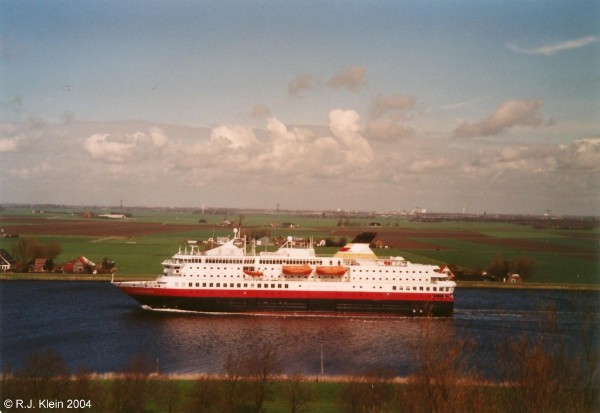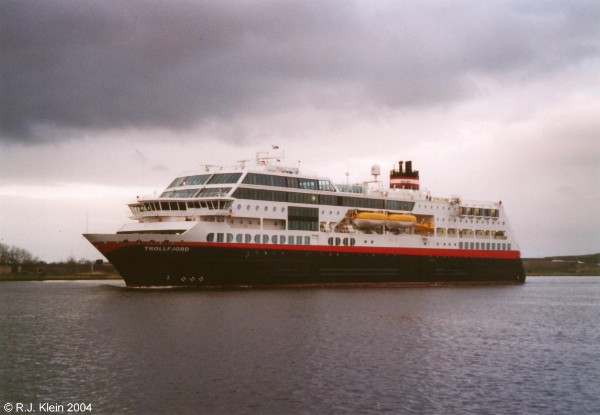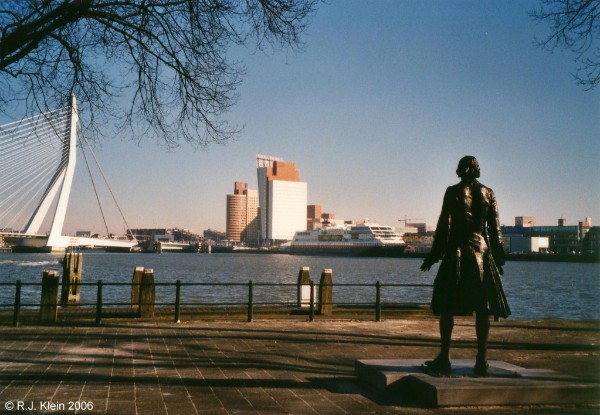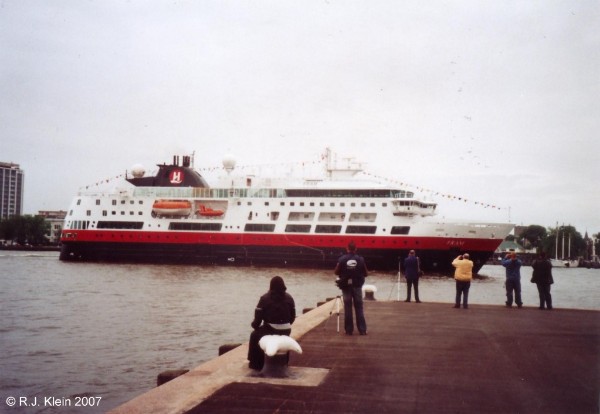|  |  |  |
Hurtig Ruten 
Nordnorge is one out of the first series of newbuilds for the Hurtig Ruten service in the 1990's. The Norwegian Fjords are known worldwide because of their outstanding natural beauty and because there is no place like it in the rest of the world. Everyone you ask about what to find in Norway will say Trolls and Fjords. As cruiseship enthousiast we will also say we know the Norwegians as pioneers in Caribbean cruising because several worldfamous cruiselines like Royal Caribbean Cruise Line and of courseNorwegian Cruise Line do have their roots in this long Northern European country. Within their inspiration to set up these cruisecompanies they had also their own shippinghistory in mind, I think. With so much coastline as they have, it is very tempting to built ships and sail around it. The Hurtig Ruten (many write it down as Hurtigruten but it are two seperate words) started in 1893 after an idea from the countries shipping advisor August Kriegsman Gran. The meaning of the name Hurtig Ruten is 'the fast route'. The route was offered to two companies, NordenfjeltskeDampskibsselskap and Det Bergenske Dampskibsselskap but they rejected it because they thought it was impossible.The new Vesteraalens Dampskibsselskap (now OVDS; the 'O' standing for Ofotens) started this service because they believed in it and they are still here, joined by Troms Fylkes Dampskibsselskap later on. Their most important role was to carry mail and goods along the coastline to a lot of ports that were barely reachable by land. This route was of significant importance to the small seaside towns of the country, because it was one of the only ways to get supplies and food. Also, these first ships were able to carry a few passengers, but this was not their most important role, at least in the beginning. Although being one of the most uneasy to reach places of the country, this route became known as 'Highway 1' in the country and this makes clear its importance.  An example of the second class of new ships added to the fleet of the Hurtig Ruten in the beginning of the new millennium, Trollfjord passes the Buitenhuizen ferry at the Northsea canal after she departed Amsterdam in the spring of 2004. Over the years, these towns at the fjords became more easy to reach by road and railway and the role of the Hurtig Ruten changed but stayed vividly alive. The route became a major tourist attraction, offering cruises along this lovely shoreline, and it still is the best way to see the fjords. Still sailing with mostly elderly steamers, TFDS and OVDS started a huge rebuilding program in the 1990's to keep up with the growing demand for Norwegian Coastal Voyages (a name where the companies are also known by outside Norway). Two classes of ships were built, the first one started with the Kong Harald for TFDS in 1992 and the Richard With for OVDS in 1993. These were followed by Nordlys (1993) and Polarlys (1995) for TFDS and Nordkapp (1995) and Nordnorge (1996) for OVDS. All these ships do have the same exteriour looks.. Midnatsol is shown below at the quayside at Rotterdam. She is one of the newest ships for the Hurtig Ruten service, built in Rissa, Norway as the thirth sister to Finnmarken and Trollfjord for TFDS. The ships of TFDS were recognized by the red-white-red funnelcolours, instead of the yellow and red funnels of OVDS. 
The second class are three ships, all built for TFDS. In 2002 Finnmarken and Trollfjord were added to the fleet, followed by Midnatsol in 2003. These ships are somewhat bigger then the earlier ships, and can carry some more passengers too. Besides this new ships, there are also still some older ships sailing. In the 1980's the fleet was extended with a class of three, the Midnatsol and Narvik of 1982 followed by Vesteralen in 1983. They have been sold to other operators nowadays. As you can see, this Northern fleet is really big. But it is still a very important way of transport in Norway, and to serve the 2.500-mile route between Bergen to Kirkeness these ships are simply needed. A voyage takes 12 days to complete in total and besides that, these ships call at thirty-four ports! In 2007 the new Fram was added to the fleet. This newly designed ship is smaller then the 1990-built ships and is especially designed for voyages to Greenland. Besides the Norwegian Coastal Voyages, the ships of the Hurtig Ruten also sail Northern European cruises, sometimes. When the Olympic Winter Games were held in Turin in 2006, Midnatsol was send there as an accomodationship and on her way to Italy she visited some Western European cities also. In march of 2006, OVDS and TFDS merged under the banner of Hurtig Ruten only. The seperate names of both companies disappeared and the ships were also given new funnelcolours as seen in the picture of Fram below. I took the picture on a rainy day at Rotterdam during her maiden voyage from Barcelona to Oslo. 
In the fall of 2014, Hurtigruten was bought by the British private equity firm TDR, with TDR recieving 90% ownership and TFDS and OVDS both retaining 5%. Since the sale, Hurtigruten invested in a few new ships as well as refurbishment of the older fleet. Also, the new owner concentrated more on other markets outside of the traditional Norwegian coastal voyages. Hurtigruten now was more seen in the Antarctic, Arctic and up the Amazon river, for example. Of course the company keeps dedicated to its roots, but also tries to place itself in the expedition cruisemarket, that sees a respectable growth in recent years.
One of the new additions to the fleet was introduced in 2018 under the name of Roald Amundsen, one of the first hybrid cruiseships in the world. She will be followed by one sistership and also two options could be added in the next years. Using hybrid propulsion, the company hopes to reduce fuel consumption as they are always present in very pristine surroundings. Also in 2018, a big change came for the old company. The core business still was the Norwegian coastalservice and this is in fact a subsidized operation for the Norwegian Ministry of Transportation and Communications. To encourage a more competitive service, from 2021 onwards the contract was given to two companies. Next to Hurtig Ruten, also Havila will enter the route with four purpose-build ships. Havila now is a Norwegian supplier of services to the international offshore industry and passengershipping is new to them. In a reaction, Hurtig Ruten stated that they were going to update their shipsfor more environmentalfriendly service and that their three largest ships, Midnatsol, Trollfjord and Finnmarken will be dedicated for the international cruisepassenger at the route. Other ships will be used in the traditional role. Also expected is that Hurtig Ruten will even more concentrate on the international expedition market.
A few ships that have sailed earlier for Hurtig Ruten are also placed at castlesoftheseas. Harald Jarl (1960-2002) is placed as Serenissima under Serenissima Cruises Mitnatsol (1984-2003) is placed under Lindblad as National Geographic Explorer. Lyngen (2005-2007) see above as Midnatsol For booking information, visit the website of the Hurtig Ruten. |
 |
|  |  |
|  |
|

